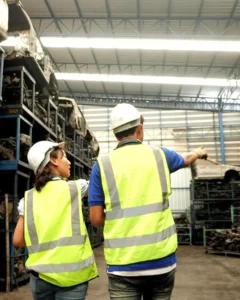Laser cutting systems are widely used in industries for their precision and ability to handle various materials. However, the performance and versatility of these systems can be significantly enhanced by incorporating the right laser accessories. These accessories play a critical role in improving the functionality, safety, and efficiency of laser cutting operations. In this article, we will explore the essential laser accessories that are commonly used in laser cutting systems, providing an in-depth understanding of how they contribute to overall performance.
1. Laser Lenses
One of the most important laser accessories for cutting systems is the laser lens. These lenses focus the laser beam to the desired spot size, directly influencing the quality of the cut and the precision of the machine. Typically, the lens will focus the laser to a fine point, optimizing the energy distribution. The quality of these lenses is crucial because any defect, such as scratches or contamination, can degrade the performance of the laser cutting machine. In addition, selecting the right lens for specific materials is essential as it influences the cutting speed and the precision of the cut. The most common types of laser lenses are zinc selenide (ZnSe) and germanium (Ge), each having distinct properties suited for different laser types.
2. Nozzles
Laser cutting nozzles are integral components that direct the gas flow and laser beam onto the material. These accessories ensure that the cutting process is smooth and efficient, contributing to cleaner cuts and reducing the risk of material deformation. The nozzle not only controls the assist gas delivery (such as oxygen, nitrogen, or compressed air) but also protects the lens from spatter and debris generated during the cutting process. Different materials require different nozzle designs. For instance, thicker materials may need larger nozzles to facilitate the proper gas flow, while smaller nozzles are ideal for precise, high-speed cuts in thinner materials.
3. Cutting Tables and Work Surfaces
A cutting table or work surface is another essential laser accessory that significantly impacts the overall cutting process. These tables are designed to hold materials securely in place while the laser cutting head moves across them. The quality and construction of the table surface directly influence the cut quality. Some cutting tables are equipped with honeycomb grids or slats, which provide better support and airflow, preventing warping or tilting of the material during cutting. The choice of work surface depends on the type of material being cut, the laser power, and the specific cutting needs of the operation. Many tables are designed to be adjustable in height to ensure optimal material positioning and prevent any damage to the workpiece.
4. Fume Extraction Systems
Laser cutting operations generate fumes, smoke, and particulates, which can compromise air quality and affect both the operator’s health and the machine’s performance. Fume extraction systems are laser accessories that capture and filter these harmful emissions, ensuring that the workplace remains safe and clean. These systems are typically equipped with high-efficiency particulate air (HEPA) filters and activated carbon filters, which remove smoke and toxic gases from the air. In addition to improving the working environment, proper fume extraction can also prolong the lifespan of the laser cutting system, as the accumulation of debris and contaminants can lead to system failures over time.
5. Laser Beam Delivery Systems
Laser beam delivery systems are responsible for transmitting the laser beam from the laser source to the cutting head. These systems are often composed of mirrors and fiber optics, each playing a key role in ensuring that the laser beam maintains its focus and intensity as it travels through the system. High-quality mirrors and fiber optic cables are essential to ensure minimal loss of power, allowing the laser to cut with greater precision. Some advanced systems also include adjustable beam delivery systems, which enable operators to customize the focus spot size and beam alignment for specific tasks, further enhancing the cutting process.
6. Motion Control Systems
The motion control system is another critical laser accessory that influences the accuracy and efficiency of laser cutting operations. These systems control the movement of the laser head across the material, ensuring that cuts are made with precision. Motion control systems typically include motors, linear guides, and drive components that are calibrated for optimal movement. Advanced systems also feature CNC (computer numerical control) capabilities, which allow operators to input precise cutting paths and coordinates. The use of high-quality motion control accessories helps prevent issues such as vibrations, misalignment, or inaccuracies during the cutting process, ensuring that the laser cutting operation is both fast and precise.
7. Rotary Attachments
For industries that work with cylindrical or tubular materials, rotary attachments are indispensable laser accessories. These attachments allow the laser cutting system to rotate the material, enabling the cutting of intricate designs and shapes on curved surfaces. Rotary attachments are used in applications such as engraving, etching, and cutting on items like pipes, rods, and tubes. The attachment ensures that the laser beam remains focused on the surface of the material as it rotates, providing consistent and accurate results even on three-dimensional objects. By incorporating rotary attachments, laser cutting systems can expand their range of applications, making them more versatile and suitable for a wider variety of industries.
8. Cooling Systems
Laser cutting machines generate significant heat during operation, which can impact both the performance of the system and the quality of the cuts. Cooling systems are essential laser accessories that regulate the temperature of the laser cutting head and other components, preventing overheating. These systems typically use water or air to dissipate heat and maintain optimal operating temperatures. In addition to keeping the system running smoothly, cooling accessories can help extend the lifespan of the laser cutting system by reducing the wear and tear caused by excessive heat. There are various types of cooling systems, including water chillers and industrial air-conditioning units, each designed to cater to different types of laser machines.
9. Safety Shields and Protective Covers
Safety is a paramount concern in laser cutting operations due to the potential risks associated with high-powered lasers. Laser safety shields and protective covers are crucial accessories that help safeguard operators and the surrounding environment. These accessories are designed to prevent exposure to the laser beam and to shield workers from any potential hazards. Safety shields are often made from specialized materials that can absorb or deflect harmful radiation, while protective covers are used to enclose the laser cutting area, reducing the risk of accidental exposure. In addition to protecting workers, these accessories also help reduce the amount of dust and debris that can accumulate around the laser machine, keeping the workspace cleaner and safer.
10. Laser Calibration Tools
To ensure the laser cutting system performs at its best, regular calibration is essential. Laser calibration tools are accessories that help verify and adjust the alignment of the laser beam, ensuring that it is accurately focused and aligned for the best results. These tools typically include laser alignment lasers, optical sensors, and adjustment equipment, which are used to calibrate the laser cutting head and ensure optimal precision. Calibration tools can help identify any misalignments or imperfections in the system, preventing costly mistakes and ensuring the cutting process remains efficient and precise.
Conclusion
Laser accessories are essential components that directly impact the performance, versatility, and safety of laser cutting systems. From lenses and nozzles to safety shields and calibration tools, each accessory plays a crucial role in ensuring that the cutting process runs smoothly and efficiently. By incorporating the right accessories, operators can significantly enhance the precision, speed, and overall quality of their laser cutting operations, while also extending the lifespan of the system itself. Investing in high-quality laser accessories is an important step for any business or manufacturer looking to optimize their laser cutting capabilities and stay competitive in an increasingly technology-driven industry.



















